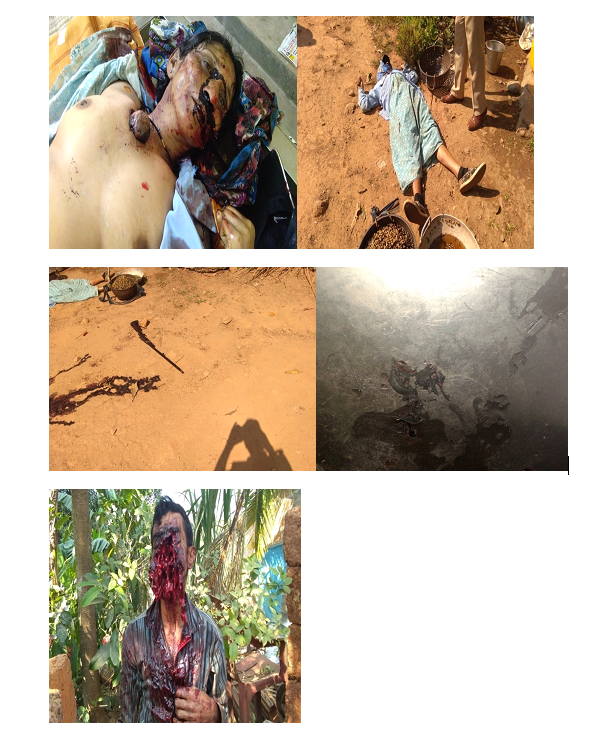Gunshot wounds are a public health concern all around the world. The forensic pathologist is often required to identify gunshot wounds, the direction and the distance of fire, the manner of injury - suicidal, homicidal, or accidental, and determine the nature and type of firearm. Gunshot wounds are complex, violent, traumatic injuries commonly encountered in forensic practice. These injuries are caused by penetration of the body with projectiles ejected from a barrel due to the ignition of gunpowder. The study of these injuries is also called wound ballistics. The severity of firearm injuries is directly proportional to the distance of the projectile fired. The data in the literature concerning the part of the body that is most often injured vary greatly. According to some literature data, the most commonly injured organs are the head and chest. The other studies cite the abdominal organs as the most commonly injured. Here are of two cases due to shotgun firing, one who fired on a woman of 43yrs old followed with firing himself to death. X-ray examination was done before conduction of the autopsy.
1. During the postmortem examination, the clothing was removed for the examination. The hole of entry wound was identified on right upper part of it which was blood soaked and margins were blackened. On the body it is observed in case of woman an entry wound of 8cms x 5.5cms with part of lung protruded out which was replaced it back. The wound was chest cavity deep, semicircular in shape, obliquely placed and situated over right side upper chest, 1.5cms below middle part of right clavicle and 2cms away from midline. Internally right side 2, 3, 4 and 5th ribs were fractured with right lung lacerated irregularly with pieces of wads and pellets were found in the cavity which was recovered for ballistic analysis. The cause of death is due to shock and hemorrhage as a result of shot gun injury sustained.
2. The other person 42yrs old was found with face disfigured beyond recognition (blast/burst injury), after realigning the skin of the face, it is observed an entry wound is over the chin with irregular margins with underlying mandible bone including the facial bone, nasal bone and palate were fractured irregularly with both eye balls missing from the orbits, skin around the entry wound had blackening at margins and over the both eyebrows and forehead. Singing of scalp hairs over frontal region present. Pieces of pellets found in facial tissue recovered for ballistic analysis. The cause of death due to shock and hemorrhage as a result of shot gun injury sustained. Smooth-bore firearms or shotguns have a completely different profile of injuries as compared to rifled firearms. This difference is determined primarily by the type of projectiles in the shotgun. Shotgun cartridges consist of multiple projectiles that disperse a short distance from the muzzle, leading to more extensive damage. The penetrating power of each projectile is, however, reduced.
Also, the significant difference between smooth-bored weapons and rifled weapons is the projectile. While a single projectile is ejected from the muzzle of a rifled firearm, the entire cartridge is released from the smooth-bored firearm. This cartridge consists of multiple tightly packed pellets that disperse as the cartridge moves towards the target. These pellets or projectiles are secured using plastic or cardboard wads that help separate the primer and gunpowder from the projectiles while also preventing the diffusion of pressure and gas upon their burning. Smooth-bore firearms, therefore, produce injuries that also show abrasions and contusion caused by the projectiles, cartridges, and wads. Also, the injury tract may contain pieces of cardboard or plastic, called wads.
Shotguns, in general, also propel the flame for a distance of 15 cm, smoke and gas for 30 cm, unburnt particles, and metal scraps for 60 cm. The contact injuries appear similar to a rifled firearm, in both pressed and loose, as well as with underlying bone and soft tissue. In pressed or firm contact injuries, the skin may present with a double muzzle imprint from the double barrels.
In general, gunshot injuries resulting from firing a smooth-bore weapon within 30 cm presents as a circular wound with smooth or crenated margins with no satellite pellets and presence of wads in the wound tract, in addition to the effects of accompanying components, including skin burns and singeing due to the flame, soiling and redding of tissue due to gas and smoke, tattooing from unburnt powder and metal scraps.
In the first case, the wound which was semicircular, hole over the cloth with blackening and singing of hairs which indicates of close range shot, the wads and pellets sent for ballistic analysis which all confirmed due to shotgun. The portion of the body targeted was on the chest by the accused.
In second case as it was a contact shotgun injury of head, which are the most mutilating firearms wounds. Extensive destruction of bone and soft tissue structures occurs with bursting of the head since the gases have restricted space for expansion. Soot is seen around the entrance in most contact wounds of head. In this case the victim was survived for few minutes as informed by eye witnesses could be due to the non-involvement of brain. But later he succumbed due to vigorous blood loss.

